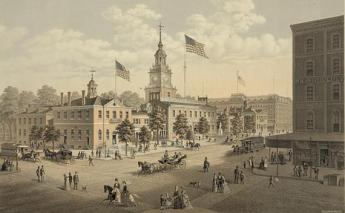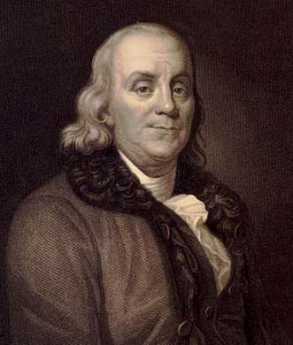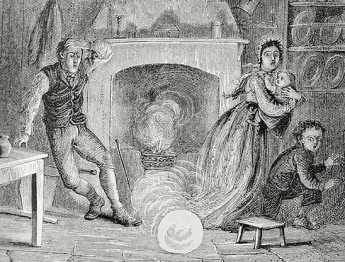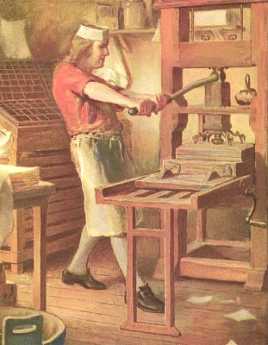Related Topics
Downtown
A discussion about downtown area in Philadelphia and connections from today with its historical past.

Benjamin Franklin
A collection of Benjamin Franklin tidbits that relate Philadelphia's revolutionary prelate to his moving around the city, the colonies, and the world.

Science
Science
Nobel Prizes
Some Philadelphians won Nobel Prizes for work done here, or elsewhere. Some prize winners would deny they are Philadelphians, but their work was nevertheless done here.
Pre-Revolutionary Philadelphia
.
Natural Science
foo
Ball Lightning, Regular Lightning, and B. Franklin
Just about everybody knows that flying a kite in a lightning storm is too dangerous to consider, but hardly anyone appreciates the enormous scientific significance of what happened at 10th and Chestnut Street in 1752. Benjamin Franklin discovered electricity, essentially explained it, displayed its commercial value with lightning rods (but never patented or profited from them), and received the acclaim of the scientific community which would have won him a Nobel Prize if such a thing had existed then. It's true this didn't happen overnight; in many ways, he made the clinching demonstration on the shores of France. Something called the torpedo fish lives there, and Franklin gathered a group of friends holding hands in a circle, demonstrating the electric shock started with the fish and traveled around the circle. Out of this appreciative circle of scientists emerged his rightful reputation as a scientist of the first rank, soon to be the most famous American in the world.
But while millions of people had observed lightning flashes before Franklin connected one to a Leyden jar, those millions were merely content to go inside the house before it started to rain. Millions more still think of the whole episode as a quaintly stupid thing to do, without much scientific or practical value. Dangerous it was indeed, and it knocked young Franklin for a loop at another time and killed several other people who tried to repeat it. But to grasp the scientific feel of it, let's put yourself in Ben's shoes. Let's look at a probably related issue, called ball lightning.

|
| Ball of Lightning |
Ball lightning is relatively uncommon, but some chronicler has calculated that about a half of one percent of the world's population has observed it. Counting from the beginning of history, that means a lot of ball lightning. Let's describe it here in the words of two Philadelphians who have actually seen it. One lady describes that she was in her kitchen on the Main Line during a thunderstorm when a big ball of light about the size of a basketball bounced through the door and sat on her stove for at least a full minute. It didn't give off much heat, didn't explode, and didn't smell bad. Although she was badly shaken emotionally, she doesn't remember anything much more. It just went away.
And another Philadelphian was on an airplane in a thunderstorm, back in the days when planes mostly flew below the clouds. A smaller blob of ball lightning appeared from nowhere and rolled down the aisle. Although no one kicked it or did anything else stupid, it created its sensation and then was gone.
A student of this matter says that although ball lightning is comparatively rare, it does occur often enough for extensive credible descriptions to exist. The size is most commonly between that of a pea and a sofa. It is not reported to give off much heat, usually but not invariably appears during a thunderstorm. Ball lightning appears to favor appearances over the ocean, and surfaced submarines seem over-represented among reporters of it. By report, the ball usually disappears with an explosion which does not sound like thunder but leaves behind a sulfurous odor. People who physically tangled with it, have been killed.

|
| Young Franklin and Print Press |
From the descriptions of crowds of people surrounding some of them, it seems unlikely these phenomena are merely visual hallucinations induced by lightning strikes, as has been suggested by some. And just what it would feel like to be that close to astronomical black holes, has not been reported by any survivors. Black holes are found scattered all over the universe, so there is no reason small ones couldn't appear on the Main Line, but it would seem likely they would be surrounded by a turbulent force field of some kind. Lots of other theories have been propounded, but haven't developed much scientific traction. In short, the state of ignorance about ball lightning today is about as total as about regular lightning bolts in the Eighteenth century.
So, there you are, a mysterious natural phenomenon which everybody ignores, just waiting for some amateur to get curious enough to devise a simple experiment to explain it. The remarkable thing about the discovery of electricity was not that it was a problem crying out for a solution, or a dangerous dragon needing to be slain. It was just something that everybody noticed, and everyone ignored. What was remarkable about this episode was not the nature of the phenomenon, but the unusual nature of the curiosity of a local printer named Ben.
Originally published: Tuesday, March 08, 2011; most-recently modified: Friday, September 20, 2019
| Posted by: Angelo | Mar 7, 2014 11:17 AM |
| Posted by: Dixie | Jul 10, 2013 1:16 PM |